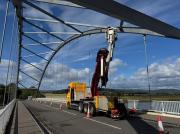Defective and Dangerous Buildings (Recovery of Expenses) (Scotland) Bill was lodged today.
31st October 2013
Highlands and Islands (Labour) MSP David Stewart lodged his Defective and Dangerous Buildings (Recovery of Expenses) (Scotland) Bill today. This is the first opposition Member Bill this session to reach this stage and aims to encourage Local Authorities to deal with the increasingly large amount of defective buildings before they become dangerous and unsightly.
The Bill will enable Local Authorities to re-coup their cost of repairing defective and dangerous Buildings to make them safe. This will in turn provide them with an extra revenue stream and hopefully help stimulate the building industry through this work. Vulnerable and low income home owners will be able, through the proposals outlined in this Bill, to carry out much needed repairs on their properties, as the charges involved can be repaid to the Local Authority over a 30 year period.
Crumbling, dangerous and unsightly buildings are a real problem across Scotland, with up to 83% of dwellings in need of some kind of repair. These are not just unsafe to the public, they are an eyesore; they can have a detrimental effect on the surrounding area by driving down house prices on a street or making town centres seem unwelcoming.
Speaking today in the Scottish Parliament, David Stewart said �Such buildings need to be dealt with in a fair and practical manner�
�Too many have been allowed to drift into disrepair and need urgent remedy. The Old Youth Hostel on Castle Street in Inverness is one example; it is not just an eyesore but creates an unwelcoming environment to the surrounding area. There are countless other examples not only across the Highlands and Islands, but the whole of Scotland. We have all seen them. �
�It is, of course, the owners� responsibility to repair buildings which may be abandoned or disused. My Bill aims to enable councils to carry out desperately needed repairs while, in turn, being empowered to pass the cost on to the owners.�
�This measure will result in more building work being carried out, providing a welcome boost to the Construction industry�
�I�ve been very pleased with the positive comments I�ve received from people in communities who are sick and tired of such buildings posing a problem locally.�
Local Authority Building Standards Scotland (LABSS) welcome the Bill by saying �At present Local Authorities find it difficult to recover the cost of work undertaken. Without the ability to apply a �charging order� on a property the Local Authority can only pursue the building owner. As such there are occasions when the Local Authority and therefore, the tax payer are left out of pocket.
Consultation summary here: http://www.davidstewartmsp.org.uk/consultation/
Further information on Bill: http://www.scottish.parliament.uk/parliamentarybusiness/Bills/46078.aspx
Related Businesses
Related Articles
Exciting Career Opportunities With The Highland Council Now Open For Applications
# 10 December 2025 Career opportunities with The Highland Council The Highland Council is looking to fill a variety of posts relating to civil engineering and flood risk management based in locations across the area. Included are opportunities specifically for civil engineering graduates and technicians, providing the ideal job with career progression for anyone recently qualified and ready for a varied and interesting role.
What the NC500 Research Projects Are Designed to Do - and Why They Matter for the Highlands
As the North Coast 500 approaches its tenth anniversary, it has become one of Scotland's most well-known tourism success stories. The 516-mile loop around the far north of the Highlands has been celebrated internationally, marketed as a world-class road trip, and credited with transforming visitor numbers in some of Scotland’s most remote areas.Help Shape the Future of Thurso
The Highland Council is inviting people that live, work, or study in Thurso, to come along to the public consultation events to have their say. This is an opportunity to help shape the future of Thurso, to gather views and ideas.
Are Scottish Councils Quietly Reversing Outsourcing? A Look at Insourcing, Cuts and the Highland IT Shift
A notable article in the Guardian on 6 December 2025 noted the high sums being paid by London councils outsourcing services to private firms. The article starts with the reduction in council funding by UK government since 2010.Council welcomes Visitor Levy flexibility plan
The Highland Council welcomes moves by the Scottish Government to introduce greater flexibility on how it could design a Visitor Levy Scheme for consultation. The Visitor Levy (Scotland) Act 2024 currently provides local authorities with discretionary powers to implement percentage-based levies following statutory consultation.Highland Council is reaching out for views to shape its next 26/27 budget.
As it looks to set out its forthcoming priorities, the council is seeking involvement from members of the public, including businesses, community groups, parents, and young people. All their opinions are going to be crucial in deciding how Highland Council will take on its budget challenge for 2026-2027.Have your say in Thurso's future £100million investment by attending public consultation events
Thurso is to benefit from £100m investment in education and community facilities and are rolling out the first phase of public consultations on 9 and 10 December 2025. The Highland Council is inviting people that live, work, or study in Thurso, to come along to the public consultation events to have their say; this is an opportunity to help shape the future of Thurso, to gather views and ideas.Finding new owners for empty homes - Scheme launched to help return more empty homes to active use
A new online portal has been launched to bring empty homeowners together with prospective buyers or developers with the aim of facilitating more properties to be used as homes again. Covering the whole of Scotland, this builds on the success of local pilots, referred to as "matchmaker schemes".Consideration for short term let control area in Skye and Raasay
Steps towards introducing a short term let control area have been considered by Highland Council's Isle of Skye and Raasay area committee. On Monday (1 December 2025) the committee heard evidence to justify the grounds for the introduction of a Short Term Let Control Area covering all or part of Skye and Raasay.Workforce North event spotlights Highland economy
EMPLOYERS and educators from across the Highlands have gathered to hear how a new initiative is aiming to transform the region's economy. Workforce North - A Call to Action brought together business leaders and teachers from primary and secondary schools from across the Highland Council area with a wide range of partners geared towards education, learning and skills development at Strathpeffer Pavillion.
